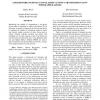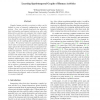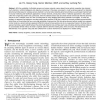16 search results - page 1 / 4 » Power-accuracy tradeoffs in human activity transition detect... |
DATE
2010
IEEE
13 years 10 months ago
2010
IEEE
— Wearable, mobile computing platforms are envisioned to be used in out-patient monitoring and care. These systems continuously perform signal filtering, transformations, and cla...
ICMCS
2009
IEEE
13 years 3 months ago
2009
IEEE
Minimizing the number of computations a low-power device makes is important to achieve long battery life. In this paper we present a framework for a low-power device to minimize t...
ICIP
2006
IEEE
14 years 6 months ago
2006
IEEE
In order to summarize a video consisting of a sequence of different activities, there are three fundamental problems: tracking the objects of interest, detecting the activity chan...
ICCV
2011
IEEE
12 years 5 months ago
2011
IEEE
Complex human activities occurring in videos can be defined in terms of temporal configurations of primitive actions. Prior work typically hand-picks the primitives, their total...
TKDE
2008
13 years 5 months ago
2008
With the availability of affordable sensors and sensor networks, sensor-based human-activity recognition has attracted much attention in artificial intelligence and ubiquitous comp...



